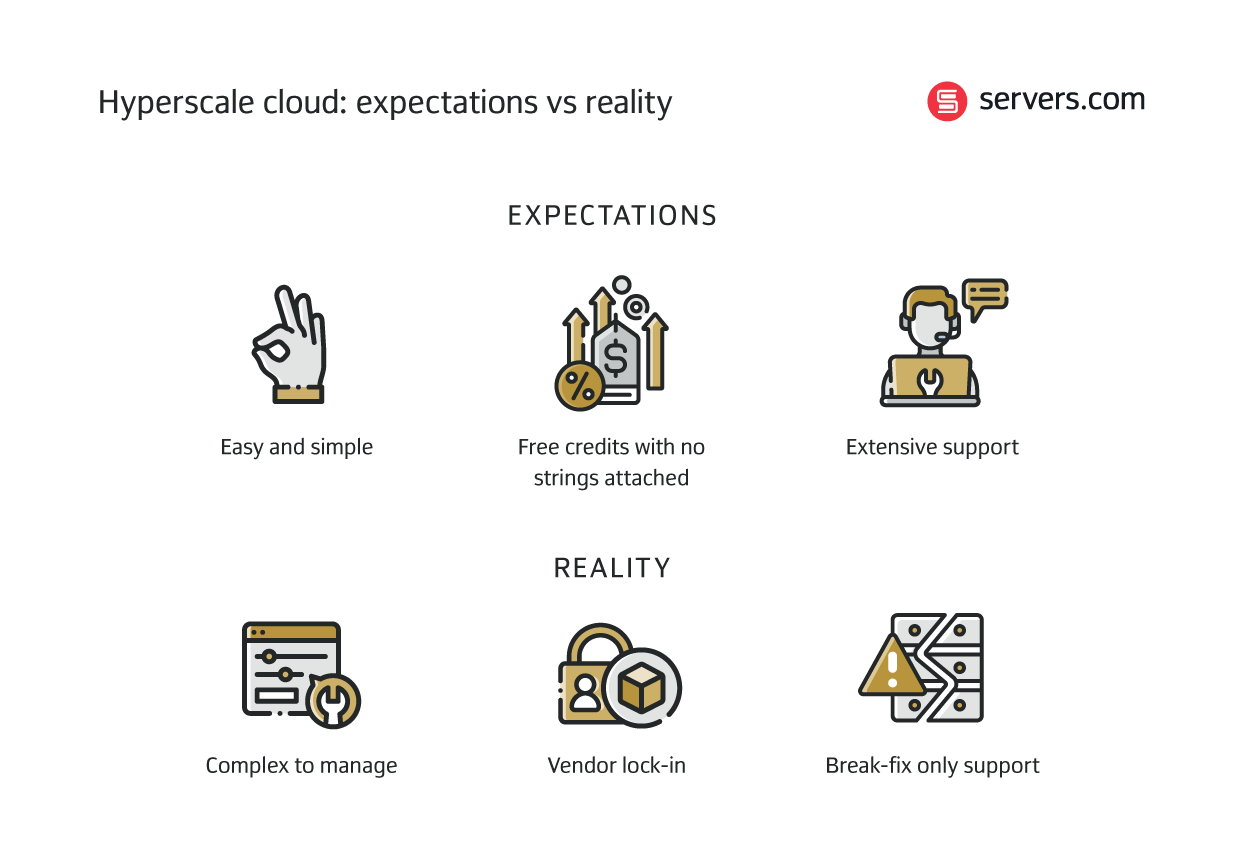

There are a lot of hyperscale cloud misconceptions. The biggest is that people think it’s going to be easy and simple.
The irony is that it once was. Simplicity was the very thing hyperscalers like AWS, Azure and GCP set out to achieve. But now these services have grown into beasts of complexity that require specialist training just to buy and use effectively.
In other words, today the reality is far from simple.
Table of contents
94% of large US organizations have worked on repatriating data or workloads from the cloud over the past three years. That’s a huge number. And it’s reflected in the conversations I’m having with businesses that signed up to hyperscale cloud environments with the expectations of simplicity but are now seriously considering a full or partial reverse cloud migration.
There are three key areas where many of them feel their expectations have not been met.
This is a common hyperscale cloud misconception.
In the days before ‘cloud-first’ became the norm, businesses would just buy compute in bare metal or virtual machines (VMs) and build out applications on top of that compute. But in modern hyperscale cloud environments, compute is just one small part of what you can do. There are an enormous number of products on offer. Everything from platform as a service to software as a service to database as a service.
It means that (a) you’ve got to become an expert in all those products and services, and (b) you’re more likely to end up building out your infrastructure architecture around those specific products and services. In other words, instead of products being built to fit a need, the need is being created around the products.
Everyone loves something that’s free. I know I do.
And when you’re building your business, especially if you’re VC funded or bootstrapped, free credits can be a great way to get off the ground.
But the hyperscalers aren’t charities. There’s always a point in time when, by giving away free credits early on, customers are getting locked into the platform. And once the bills start rolling in, those customers end up paying substantially more than they would if they’d never gotten locked into the platform in the first place.
It’s something game server orchestration platform, Gameye, is familiar with:
“We’ve had developers come to us saying ‘we just ran out of credits, and our bill went through the roof. How can you help us keep this down?'” shared Andrew Walker, Head of Business Development at Gameye.
Take the free credits if you need them. But make sure that you’re building your platform in a way that means you can leave when the bills start.
If you ask me, this is where hyperscalers let themselves down the most. And if you’ve ever been a hyperscale cloud customer yourself, you’ll know what I’m talking about.
I spoke to an iGaming CTO recently who put it very succinctly: “you rarely get proper attention for things that matter to your business but are not critical for your cloud provider”.
The hyperscalers have fantastic sales teams. But once you’re in and you need technical support, help becomes hard to come by (unless you’re willing to pay a significant premium on top of your existing spend).
I was once a hyperscale cloud customer and I quickly learned not to expect anything beyond break-fix, ticket-only support. It can take days to get a response, and you’ll probably just be pointed to a knowledge base article with outdated information that doesn’t even match the portal.

All this is not to say that hyperscale cloud is never the right choice. It is sometimes.
For example:
If you’re a new business, there’s no reason not to take advantage of the free credits on offer. Just make sure that you build your platform in a way that means you won’t become tied to your provider. That way, when the bills inevitably get bigger, you’ll be able to migrate your platform to a more cost-effective solution without having to completely re-engineer and re-architect.
Even David Heinemeier Hansson, who speaks extensively on the benefits of cloud exit, points to hyperscale’s unique benefits for some specific use cases.
In this recent BBC News article he was quoted:
“When you have a speculative start-up and there’s great uncertainty as to whether you’re going to be around in 18 months, you should absolutely not spend your money buying computers”.
If you’re a platform like Netflix with incredibly unpredictable infrastructure scaling patterns then, yes, you will need to rely on hyperscale cloud. But your resource requirements need to be exceptionally volatile for this to be true.
If not, there are plenty of other setups that can give you what you need. There are very few times when hyperscale cloud is the only good option. In most cases it’ll work best as part of a hybrid infrastructure environment combined with some bare metal, on-prem, or colocation where it makes sense.
If you’re currently in hyperscale and looking for a way out but don’t know where to start, you’ll need a cloud exit strategy plan in place.
Start by looking at your current infrastructure stack. Look at what products and services you’re already using – this will make a big difference to the route you ultimately take.
For instance, if you’re with AWS and you’re only using Elastic Compute Cloud (EC2) then migrating away from AWS is going to be relatively simple. Because there are a lot of other services out there that will allow you to lift-and-shift your setup away from EC2.
But it’s a totally different story if you’re using hyper-specific AWS products like platform as a service or elastic database as a service. These are not easily available on other providers, or as a bare metal or colocation product. You’ll need to re-engineer or re-architect your infrastructure which will take significant time and resources.
The key is to get a very clear understanding of what your requirements are to start with, and to plan in any expected engineering time that will be required for you to move away from hyperscale cloud. Once you’ve got that information, then you can start speaking to vendors and getting quotes.
In most cases, the earlier you re-architect, the more you’re going to save.
You’re not alone.
There are so many other people out there that have found out the hard way that their hyperscale cloud expectations were actually hyperscale cloud misconceptions.
The good news is that there are alternatives to hyperscale cloud. Other infrastructure as a service (IaaS) solutions like bare metal hosting are a great option. But there’s also on-prem, colocation, or a hybrid infrastructure approach combining multiple compute types and providers.
Ultimately, you don’t have to (and probably shouldn’t) go all-in with any one single compute type. Just choose what’s right for your business in each location –it’s unlikely to be the same everywhere.

With a decade in hosting and video game hosting, Isaac knows the big mistakes and how to help customers avoid them. Dog dad to Lilly, he owns all the tools and lives his best lawn life.